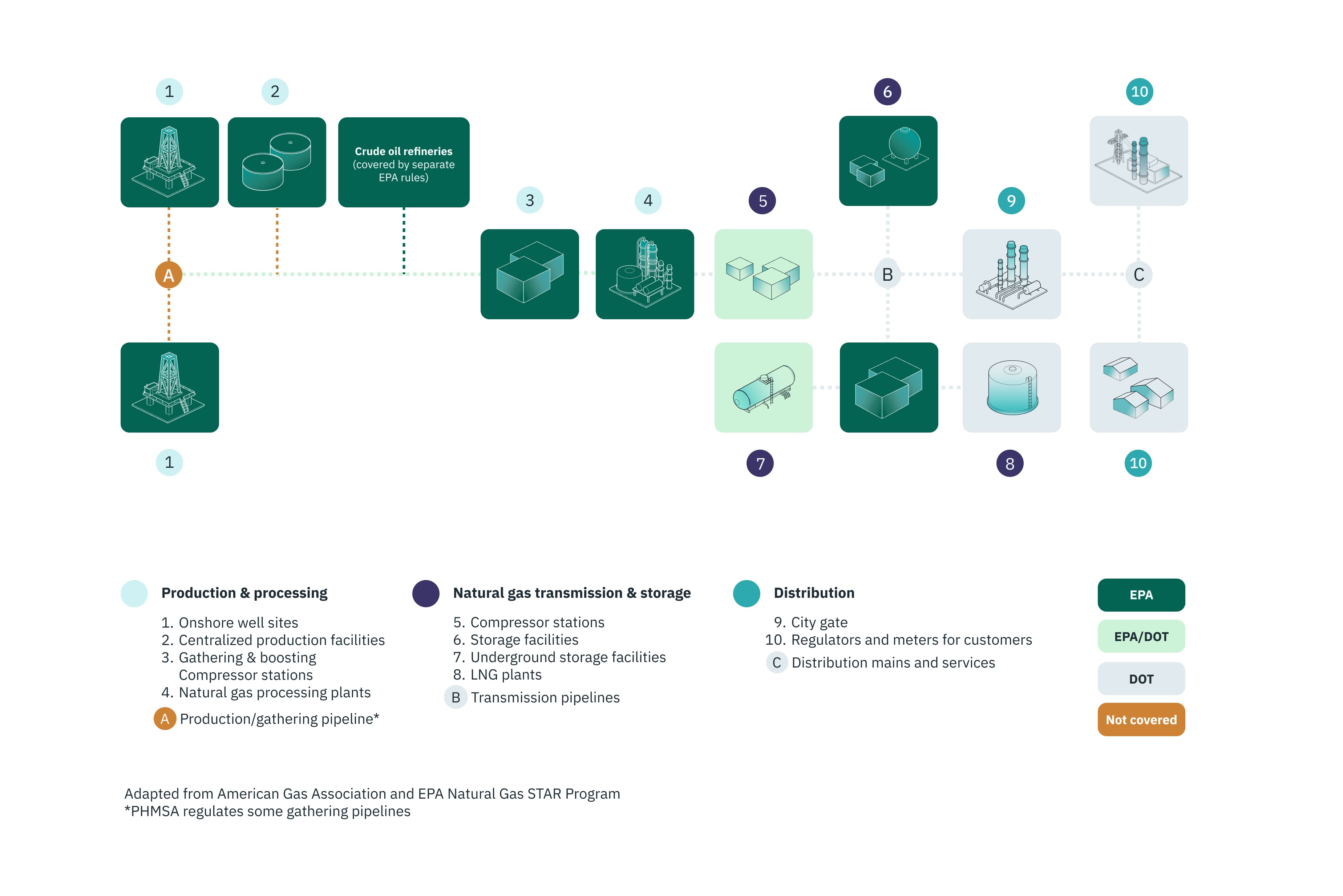.png)
Regulatory update: Advanced leak detection requirements for gas pipelines
Name of regulation: Pipeline Safety: Gas Pipeline Leak Detection and Repair
Stage: Proposed rule
Agency: U.S. Department of Transportation (DOT), Pipeline and Hazardous Materials Safety Administration (PHMSA)
On May 18, 2023, the Pipeline and Hazardous Materials Safety Administration (PHMSA) proposed updates to regulations addressing pipeline leaks. These proposed amendments would require operators to find and repair all leaks from gas gathering pipelines, transmission pipelines, gas distribution systems, underground natural gas storage facilities, and liquified natural gas (LNG) facilities. Additionally, owners and operators would be required to minimize vented emissions from blowdowns.
Why is PHMSA proposing these requirements?
PHMSA has proposed these amendments under the authority of the PIPES Act of 2020, which extends PHMSA’s regulations to not only account for safety, but to also include considerations of environmental harm. Current regulations focus on avoiding risks to public safety resulting from instantaneous, large volume releases or accumulated gas from gas pipelines. However, those regulations lack specificity on leak detection and repair requirements, and grant discretion to operators to determine what constitutes a leak needing more immediate repair.
There are many nuances to the proposed amendments, including the use of an advanced leak detection program (ALDP), reduced emissions from blowdowns, leak grading specifications, and reporting for purposes of national pipeline mapping. The ALDP is a new section to PHMSA’s current regulations, and warrants additional review and consideration for comment and/or data submissions while the public comment period is open.
What leak detection and repair requirements are proposed?
PHMSA proposes an ALDP that would be developed by owners/operators. The overall program requirement is to use an advanced gas detection technology to detect leaks that are 5 ppm or greater when detected within a 5 foot distance of the pipeline. Owners/operators would develop a written plan that includes information on the detection equipment used to detect, locate, and investigate leaks. Any leak detected would be repaired, with repair timelines dependent on the leak grading specifications. Larger leaks that pose considerable risk to public safety or the environment would have to be repaired on a shorter timeline than other smaller leaks. Detection equipment allowed under the proposed ALDP include handheld equipment, mobile/aerial/satellite-mounted equipment, continuous monitors, and optical/infrared/laser-based equipment. Leak surveys would be required at specific frequencies, depending on the type of pipeline/facility, ranging from quarterly to annually.
All transmission and distribution pipelines would be subject to these proposed leak detection programs, but only a portion of gas gathering pipelines would be regulated. These gas gathering pipelines include those with an outer radius of 8.625 inches or greater that are located near occupied buildings. This represents a small fraction of the approximately 400,000 miles of gas gathering pipeline in the U.S. While not proposed, PHMSA does seek comment and data that would support expanding these requirements to all gas gathering pipelines. Information from recent studies indicate that the gas gathering and boosting segment is a significant source of methane emissions. This type of information could be used by environmental groups to compel PHMSA to extend regulations to all gas gathering pipelines.
How does this proposal compare to EPA’s methane rulemaking?
PHMSA and EPA have attempted to coordinate their rulemaking efforts, including joint participation in public meetings where information on advanced methane detection technologies were discussed. Additionally, PHMSA includes an exemption in their proposal from the ALDP requirements for gathering and boosting compressor stations and transmission compressor stations that are subject to and in compliance with EPA’s forthcoming rules for new sources (NSPS OOOOb) and any state plans conforming with the emission guidelines for existing sources (EG OOOOc). That exemption would be limited to the compressor station, and not include pipelines outside the station, as EPA’s rules do not apply to pipelines at this time. The graphic below shows where EPA and PHMSA regulations would apply, and is provided from the U.S. Methane Emissions Reduction Plan issued in November 2021.

Work with industry experts to assess risk against evolving emissions requirements.
Owners and operators of pipelines, LNG facilities, and underground natural gas storage facilities should familiarize themselves with the proposed requirements in this PHMSA regulation. The public comment period is open until July 17, 2023, and detailed comments can help PHMSA prepare a final rule that can be implemented more easily.
Get in touch with us to learn more about how Validere’s MRV software and team of experts can help your business gain a better understanding of relative emissions performance to assess risk against changing requirements.

Karen Marsh
Prior to Validere, Karen Marsh served as a senior environmental engineer and lead regulation developer for the U.S. EPA, authoring key regulations such as New Source Performance Standards for the oil and gas industry. Karen brings 15+ years of experience in developing regulations to reduce methane emissions, various LDAR regulations, fugitive emissions detection, air permitting, and GHG reporting.
